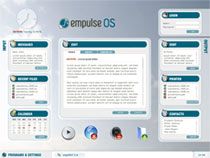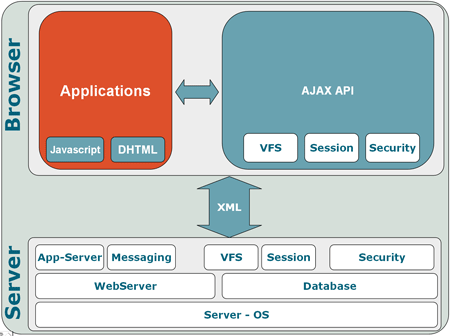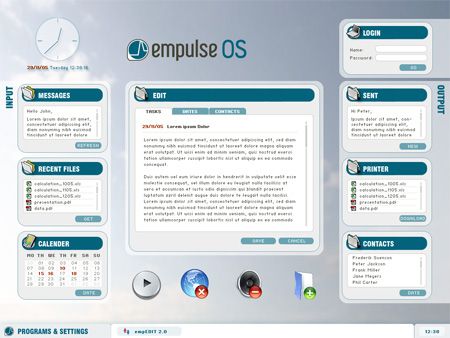Web Operating Systems
– The future of Internet(?)

Could you imagine editing your personal documents on any PC connected to the internet? Doing word processing, spreadsheet calculations, personal emailing in the environment you are used to, just after logging into your personal account in a Web-Browser?
No, that’s not possible you might say, because there are different operating-systems, applications, versions, and most probably you won’t have any access to your personal data.
If one looks at the development of internet technology during the last 12 months, and combines new ideas while thinking ahead, one could come to the conclusion, that this vision will not be so far away. Based on Ajax and other so called Web 2.0 applications this scenario could come true sooner as one might think…
Hot Stuff: Flickr, Zimbra, writely &co
A couple of new applications that are available through the internet are using Ajax features intensively. You already can use your browser-based word processing (www.writely.com), Groupware (www.zimbra.com) , Spreadsheet (www.numsum.com), calendar (www.kiko.com), picture viewer (www.flickr.com) or even integrated office suites (www.goffice.com, www.thinkfree.com). Although running in a standard browser, these and many other applications, have a much improved user interface and usability compared to conventional HTML-page based Websites. Sometimes one might not even see a big difference to standard desktop applications.
A potential way of integrating all this into one common user interface is shown by www.protopage.com, an ajax based framework for “windowing” within a web browser.
Users are changing their attitude
One of the first applications that used ajax and caused this approach to become known to a broad public was Google Mail. Gmail already changed the attitude of people using the web. Instead of downloading emails to locally installed email programs like outlook, users are using gmail as their single mail management system. A prerequisite for this development is also the cheap and fast internet access via Leased Line or WLAN, the tremendous mail space of 2 GB that google offered and smooth features like search engines. Besides technical features, there is an important need for trust in the provider of such systems regarding security and confidentiality when personal data is kept.
Will my personal data end in nirvana ?
Data storage and secure backup surely is one of the most delicate issue regarding this type of “network based computing”. Many users may ask themselves, if documents containing personal data are secure and safe from access by other people and loss of data. It will be a challenge to built up hosting services, that assure the necessary security and have a brand and company background that make them trustworthy enough. On the other hand a good service might improve data security for a lot of people because many PC users are not doing their backups frequently enough (ever heard of it ?).
Rebirth of Application Service Providing ?
One might say that applications with a lot of graphical interactions like photoshop or powerpoint will never be placed into a web-browser effectively. On the other hand, web based applications will improve the trend towards ASP- and outsourcing models in the business area. One example of such a service is salesforce.com, the fastest growing Software company in the CRM Sector. Business customers are using salesforce.com web based and hosted software without installing any hardware or software inhouse, simply accessing it through the internet browser. The options to provide effective ASP Services will grow by using Rich Internet applications technologies like AJAX.
So far. so good?
What is still missing in this new world of applications is a common framework, a kind of operating system that provides basic services for storing files, accessing databases and managing print output.
Will Google be the Microsoft killer ?
Rumours say some of the big players are developing concepts for such a framework. Google, is working on a thing called googleOS or GooOS. First screenshots have been seen in the internet, but they could be faked by some creative graphics designer. Yahoo’s recent acquisition of flickr and konfabulator make sense, especially if they are heading up to be a Web applications system integrator. The recently announced partnership of SUN and Google brings the main sponsor of openoffice and one of the AJAX trendsetters together.
All this might be reason enough for Microsoft to pay high attention to avoid getting overtaken by these changes. Taking a more detailed look at Windows Vista, one will see that major new features related to Internet explorer V. 70 in enhancing his network-possibilities (RSS Feeds etc.)
Offline and Off-Life ?
Critics may argue, that even today there are too many situations in which you want to work with your computer, but do not have any access to the internet. Neither through WLAN nor through UMTS or other mobile connectivity. To face this challenge, the architecture of a Webos could be extended by a small web server installed on the client machine. Using a standardized implementation, platform independency can be kept and you can use your applications via a Windows, Mac or Linux browser. Mozilla, is said to be already working on a Firefox version, that contains a smart local web server in its native installation package.
Any OpenSource yet ?
Although a big part of new ajax web applications is being developed under Open Source licences (.e.g. Zimbra, ajaxoffice), there does not seem to exist a initiative for an WebOS yet. We started thinking about features and functionalities of such a framework – lets nickname it “empulseOS”- should have. The architecture of empulseOS can be based totally on existing building blocks. On the server side we would use Apache, Tomcat / Jboss, Mysql and a Virtual File System already available within OpenCMS. On the client there is nothing new either. Javascript, DHTML and the communication to the server via XMLhttp request (better known as ajax). Printing output will be done via PDF-creation, storing files in a special folder within your personal virtual file system. The major task is to write an API for gui-handling, session management, security etc. and to provide services to web applications that make development easier, faster and standardized.

Designing the graphical user interface is a challenge too. We all are more or less stuck in the way of using a GUI like Windows, Gnome or OS/X. Gmail has shown us, that for web based applications there might be other approaches that work quite well and people get used to it immediately. New ideas can be brought up in order to create a user interfaces that combines flexibility and efficiency in a good way.

Conclusion: Things are getting exciting again
We still can not be sure if technology and the market are mature enough to establish a WebOperating System- like the empulseOS approach. There are a lot of hurdles to take, especially in the sector of security and platform independency. But we know, that Web 2.0 and its technologies will change the way we look at the internet. And its realy worth thinking beyond barriers and develop some “beta”. If you want to share these thoughts, criticize the approach are contribute in a development, you are very welcome to comment in the blog or write us to kontakt@empulse.de
Über den Autor
empulse Team
Unser kompetentes und erfahrenes Team von (Java-)Entwickler ist stark in Beratung, technischer Konzeption und zuverlässiger Umsetzung komplexer Projekte. In unseren Reihen haben wir Spezialisten für unterschiedliche Themengebiete, die hier ihr Fachwissen zum Besten geben.